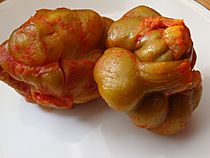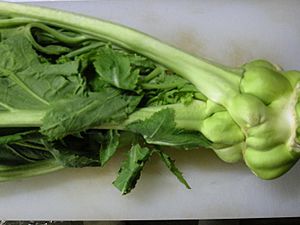Zha cai facts for kids
Quick facts for kids Zha cai |
|||||||||||||||||||||
|---|---|---|---|---|---|---|---|---|---|---|---|---|---|---|---|---|---|---|---|---|---|

Whole heads of zha cai coated in chili paste
|
|||||||||||||||||||||
| Chinese | 榨菜 | ||||||||||||||||||||
| Hanyu Pinyin | zhà cài | ||||||||||||||||||||
|
|||||||||||||||||||||
Zha cai (pronounced "jah tsai") is a special kind of pickled vegetable from China. It comes from a mustard plant and is very popular in Chinese cooking. This tasty pickle started in a city called Chongqing.
You might also see its name spelled as Cha tsai or Sichuan vegetable. These names are often used for other Chinese pickles too. Zha cai is known for its unique flavor and crunchy texture.
Contents
How Zha Cai Is Made
Zha cai is made from a specific part of the mustard plant. This part is a big, lumpy, green stem that looks like a fist. It's called Brassica juncea subspecies tsatsai.
First, the stems are covered in salt and pressed. Then, they are dried. After that, they are rubbed with a spicy red chili paste. Finally, they are put into a special earthenware jar to ferment. This process is similar to how Korean kimchi is made.
What Zha Cai Tastes Like
The flavor of zha cai is a mix of spicy, sour, and salty tastes. It has a very unique texture that is both crunchy and tender. It's a bit like pickled cucumbers, but different.
Before using zha cai, people usually wash it. This helps to remove the chili paste and some of the extra salt. Soaking it in fresh water also makes it less salty. Zha cai is known for its rich "umami" flavor. The spiciness can change depending on how much chili paste was used when it was made.
How Zha Cai Is Used in Cooking
Zha cai comes from the Sichuan region of China. Many people believe it is one of the oldest types of pickles in the world. It is used in many different Chinese dishes.
For example, it's a key ingredient in Sichuan dan dan noodles. It's also added to soups with ground pork and rice noodles. People often eat it as a side dish with rice congee, which is a type of rice porridge.
Because zha cai is very salty, it's usually cut into thin strips. Only a small amount is used in dishes. If it's too salty, you can soak the strips in water before you cook with them.
A popular Chinese dish is "noodles with Zha Cai and shredded pork" (榨菜肉絲麵; zhà cài ròusī miàn). Zha cai is also found in ci fan tuan, a popular food in Shanghai cuisine. In Japan, zha cai is called zāsai (ザーサイ) and is often found in Chinese restaurants. The Japanese version is usually less spicy.
Like other vegetable stems in Chinese cooking, such as celtuce, zha cai can also be sliced and stir-fried.
Where Zha Cai Comes From
The city of Fuling in Chongqing is very famous for zha cai. The biggest company that makes zha cai is Fuling Zhacai. They produce the Wujiang (乌江) brand. In 2021, this company celebrated selling 15 billion packets of zha cai!
See also
 In Spanish: Zha cai para niños
In Spanish: Zha cai para niños



